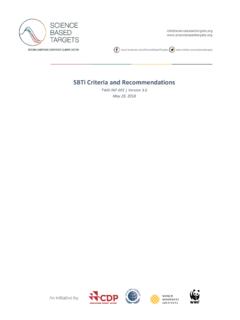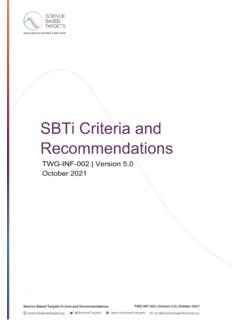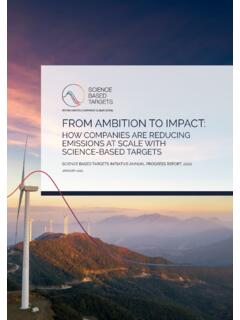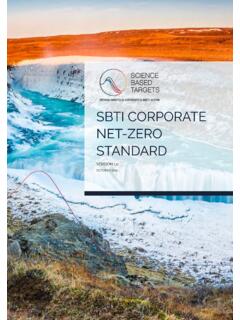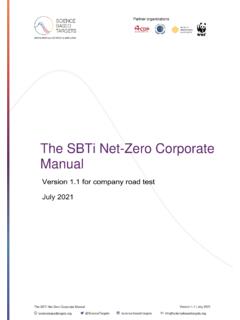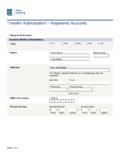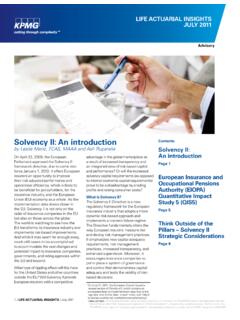Transcription of FINANCIAL SE CTOR SCIENCE-BASED TARGETS GUIDANCE
1 FINANCIAL SECTOR SCIENCE-BASED . TARGETS GUIDANCE . VERSION August 2022. Version Change/update description Date Effective Dates Finalized Pilot The pilot version of the FI GUIDANCE and Criteria October October 2022. 2020 to January 2022. No changes made to criteria/ GUIDANCE . Version changed February February 2022. from pilot to to recognize the end of the pilot phase 2022 to July 2022. Clarification for loan coverage metric, that financed July 2022 From August emissions can be used to cover the 67% minimum 2022. threshold. Clarification to the coverage footnote (footnote B), that SME lending does not have to be included in the calculation of the minimum 67% coverage Table of Contents Table of Contents ..1. Acknowledgments ..3. Executive 10. 1. Introduction .. 16. Purpose of this Document .. 16. The SBTi's FINANCIAL Sector Project Audience.
2 19. The SBTi's FINANCIAL Sector Project Context .. 19. What Are SCIENCE-BASED TARGETS (SBTs)? .. 20. How is the FINANCIAL Sector Addressing Climate? .. 22. 2. Business Case for FINANCIAL Institutions to Set SCIENCE-BASED TARGETS .. 25. 3. SBTi Target Validation Criteria and Recommendations for FINANCIAL Institutions .. 26. GHG Emissions Inventory and Target Boundary .. 27. Scope 1 and 2 Target Time 29. Scope 1 and 2 Target Ambition .. 29. Scope 2 .. 30. Scope 3 Portfolio Target Setting Requirements .. 31. 34. Recalculation and Target Validity .. 35. 4. How to Set SCIENCE-BASED 37. Compiling a GHG 37. Measuring Financed Emissions to Facilitate Target Setting .. 40. How to Set a SBT for Scope 1 and 2 Emissions .. 44. 5. Approaches to Setting Scope 3 Portfolio TARGETS .. 49. Background and Brief Literature Review.
3 49. Overview of Available Asset Class Specific Methods, Broader Methods, and Existing Gaps .. 50. Defining the Boundary of Portfolio TARGETS .. 53. Description of Methods to Set Portfolio TARGETS .. 58. Approaches to Setting TARGETS on the Rest of the Scope 3 Categories .. 92. Coal Phaseout and Fossil Fuel Disclosure .. 93. 6. How to Communicate SCIENCE-BASED TARGETS and Tracking Progress .. 96. Tracking and Reporting Target Progress .. 99. Target Recalculation and Validity .. 100. 7. How to Achieve SBTs .. 102. Integration of Climate Change in Governance and Decision-Making .. 102. Engaging Key Stakeholders: Companies, Service Providers, and Policymakers .. 103. Public Disclosure of Climate Actions .. 107. 8. SBTi Call to Action Process: Commit, Develop Target, Validate, Announce, Disclose .. 109. Step 1: Commit to Set a SCIENCE-BASED Target.
4 109. Step 2: Develop a Target .. 110. Step 3: Submit the TARGETS for a Validation .. 111. Step 4: Announce the 112. Step 5: Target Disclosure .. 112. 9. Discussion and Areas for Further Research .. 113. Appendices .. 115. A. SDA for Residential Mortgage .. 115. B. SDA for Commercial Real Estate .. 125. C. SDA Electricity Generation Project Finance .. 135. D. SDA for Corporate Debt and Equity .. 144. E. Temperature Rating Method .. 151. F. SBTi Finance Temperature Rating and Portfolio Coverage Tool .. 156. 169. FINANCIAL Sector SCIENCE-BASED TARGETS GUIDANCE 2. Acknowledgments PRIMARY AUTHORS. Chendan Yan, World Resources Institute Nate Aden, World Resources Institute Cynthia Cummis, World Resources Institute Eoin White, CDP Worldwide Jan Vandermosten, World Wildlife Fund Donald Linderyd, World Wildlife Fund Chris Weber, World Wildlife Fund TECHNICAL PARTNERS.
5 Giel Linthorst, Guidehouse Ang lica Afanador, Guidehouse EXPERT ADVISORY group . The following individuals provided expert feedback and direction on GUIDANCE development. They did so in a personal capacity, and their views did not necessarily represent the views of their Anna Viefhues, AMF Pension Stuart Palmer, Australian Ethical Investment Jochen Krippner, Barclays Jean-Yves Wilmotte, Carbone 4. Tim Stumhofer, ClimateWorks Foundation Ian Monroe, Etho Capital and Stanford University Kaitlin Crouch, ING Bank Maximilian Horster, ISS ESG. Dr. Nicole R ttmer, PricewaterhouseCoopers GmbH Wirtschaftspr fungsgesellschaft Marcus Lun, RBC Global Asset Management John Gelston, Standard Chartered Greg Liddell, Suncorp group Jes Andrews, United Nations Environment Programme, Finance Initiative Neil Patel, Voya FINANCIAL Philip Tapsall, Westpac Eric Christensen, WSP.
6 1 This list does not represent all Expert Advisory group (EAG) members who have contributed to the framework development. More members may be added to the list. FINANCIAL Sector SCIENCE-BASED TARGETS GUIDANCE 3. METHOD ROAD TESTERS. The following organizations provided valuable feedback on the robustness and practicality of the draft SCIENCE-BASED target setting methods through the method road-testing process led by Science Based TARGETS initiative (SBTi) in 2019. ABN AMRO Bank ACTIAM. AMF Pension ASN Bank ASR Nederland NV. Bank Australia Bankinter BNP Paribas ING. Ita Unibanco La Banque Postale and La Banque Postale Asset Management Morgan Stanley Netherlands Development Finance Company (FMO). Nordea Life and Pension Skandia Sompo Holdings, Inc. Swedbank AB. YES BANK, Ltd. TEMPERATURE RATING AND SBT PORTFOLIO COVERAGE TOOL.
7 The SBTi tool development process included many partners and beta testers. We would like to particularly thank: Christian Schmidli; representatives from Allianz; Bloomberg; ISS ESG; MSCI; Ortec Finance; OS-Climate; Trucost; Storebrand; and Urgentum for their participation. We would also like to thank all beta testers who provided valuable feedback on the tool development process. Project Team Technical Partners Daan van de Meeberg, Ortec Finance Lisa Eichler, Ortec Finance Joris Cramwinckel, Ortec Finance Hewson Baltzell, Helios Exchange Truman Semans, OS-Climate Wilder Marsh, OS-Climate FINANCIAL Sector SCIENCE-BASED TARGETS GUIDANCE 4. Data and Service Provider Collaborators Bloomberg CDP. ISS ESG. MSCI. Trucost Urgentem User group Collaborators Allianz Net Zero Asset Owner Alliance Storebrand Tool Beta Testers Mohammad Fesanghary and Arun Verma, Bloomberg Carbon Intelligence AS.
8 Dr. Nicole R ttmer, PricewaterhouseCoopers GmbH Wirtschaftspr fungsgesellschaft EcoAct Goldman, Sachs & Co. Lombard Odier Investment Managers Manulife Investment Management Oliver Canosa ShareAction Tribe Impact Capital LLP. We are thankful to Caisse de d p t et placement du Qu bec (CDPQ), ClimateWorks Foundation, Partnership for Carbon Accounting Financials (PCAF), Keeling Curve Prize, Hewlett Foundation, and the Bank of New York Mellon for their generous FINANCIAL support. FINANCIAL Sector SCIENCE-BASED TARGETS GUIDANCE 5. Executive Summary Context The COVID-19 pandemic has accelerated several ongoing transitions, including the interdependence between FINANCIAL institutions and our changing climate. While FINANCIAL institutions' business models are vulnerable to climate disruptions, greater attention is also being given to the influence of investment and lending portfolios on climate outcomes.
9 This transition is marked by unprecedented growth of environmental, social, and corporate governance (ESG) investments, a profusion of high-level climate commitments by FINANCIAL institutions, and burgeoning FINANCIAL regulatory action on climate-related FINANCIAL FINANCIAL institutions are seeking to lead zero-carbon transformation rather than just minimize risks related to climate impacts. To decarbonize the global economy in alignment with the goals established by the Paris Agreement, all economic actors in the real economy need to reduce their greenhouse gas (GHG) emissions at a rate sufficient to be consistent with the emissions pathways established by climate science. FINANCIAL institutions (FIs) differ from other economic sectors: they provide finance and other services to the companies that are responsible for reducing GHG emissions, rather than exercise direct control over GHG emission reductions.
10 The central enabling role of finance is recognized in the Paris Agreement's Article (c) on making finance flows consistent with a pathway towards low greenhouse gas emissions and climate-resilient development. The Science Based TARGETS initiative (SBTi) defines FINANCIAL institutions as companies whose business involves the dealing of FINANCIAL and monetary transactions, including deposits, loans, investments, and currency exchange. If 5 percent or more of a company's revenue or assets comes from activities such as those described above, they are considered to be FINANCIAL institutions. The SBTi framework for FINANCIAL institutions aims to support FIs in their efforts to address climate change by providing resources for SCIENCE-BASED target setting. The framework includes target setting methods, criteria, a target setting tool, and this GUIDANCE document.

